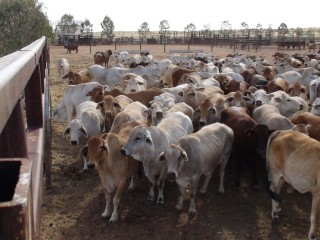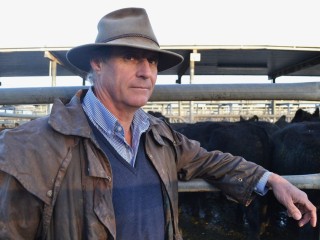 Southern processors have welcomed the influx of prime cattle being consigned from northern pastoral areas this year, helping to overcome the squeeze on supply due to tight seasonal conditions in western Victoria and South Australia’s South East.
Southern processors have welcomed the influx of prime cattle being consigned from northern pastoral areas this year, helping to overcome the squeeze on supply due to tight seasonal conditions in western Victoria and South Australia’s South East.
However, northern supplies have been curtailed by limited accessibility to southern abattoirs, especially from Channel Country properties, which have been frustrated by transport restrictions along the Birdsville Track.
While the autumn/winter period is normally the quietest time of year for the supply of killable cattle in the south, the early spring shut-off last year and relatively dry conditions since has forced processors to look outside of normally reliable southern beef regions to source numbers.
Livestock manager at Teys Naracoorte, David Woolard, said his plant had subsequently processed a high number of pastoral cattle this year.
“As the season in the South East and western Victoria cut-off a bit early last year, our local cattle have not been available, especially high quality cattle,” Mr Woolard said.
“The cattle from the pastoral areas have certainly helped our supply, and as they have had a couple of good years, most of the northern cattle are in very good order.”
Mr Woolard said the Naracoorte plant was well situated to receive cattle from pastoral areas, especially during autumn and winter, when southern supplies typically tighten.
“This works well, giving Teys Naracoorte a good supply of cattle over the 12 month period. Obviously this is also good for producers in the pastoral areas, giving them the option to sell to Teys Naracoorte when we require cattle and when other processors in the north and east may have plenty of cattle around them,” he said.
“Due to some good seasons, northern pastoralists have had the option to finish their cattle, rather than sell them as stores. Quite a few have also had enough feed available to either purchase cattle to finish or take on agistment cattle.”
 Mr Woolard said these factors opened the door for an increased flow of pastoral cattle into the Naracoorte plant.
Mr Woolard said these factors opened the door for an increased flow of pastoral cattle into the Naracoorte plant.
However, accessibility issues are preventing an even greater number of cattle being sent south, especially in the flood-prone areas of South Australia’s far north-east and Queensland’s south-west.
Greg Campbell, managing director S Kidman & Co, said his company was forced to send cattle to Queensland processors due to accessibility issues, especially on the Birdsville Track.
“Outback transport issues play just as important a role as grid pricing does in determining the market for cattle,” Mr Campbell said.
In the six months to the end of June, 11,500 Kidman cattle were consigned to Teys Naracoorte, most of which were sourced from the company’s stations in south-west Queensland.
“And there are more on the road each week,” Mr Campbell said.
But Mr Campbell cited two significant factors limiting the supply of Kidman cattle to southern processors like Teys at Naracoorte and T&R Pastoral at Murray Bridge.
“One is the inaccessible nature of the Birdsville Track at the Coopers Creek crossing, where trucks haven’t been able to cross for periods of six months during recent floods,” he said.
“This prevented a potential 15,000 Kidman cattle being consigned to SA meatworks from the company’s Georgina and Diamantina properties during 2011.”
“Depending on whether this beef is sold domestically or exported, the multiplier effect of this approximately $15 million in farm gate value lost to SA could be from $45m to $75m as it moves through transport operators, extra shifts in meatworks, the cold chain, value-adding in the domestic retail or export chain.”
Mr Campbell said S Kidman & Co was one of a number of large cattle producers in the Channel Country who were being forced to overlook to SA processors for the consignment of their cattle.
“It’s a lesser but similar story at Innamincka. The lack of an effective causeway over the Cooper Creek at Innamincka has closed that road for up to nine months in a single flood event, but regularly for three or four months.
“Cattle loaded on trucks at the Innamincka homestead on the north side of the Cooper face a five hour trip via the Nappa Merrie bridge around to the Innamincka township. When the crossing isn’t flooded this trip is 3km.
“This, coupled with the freight inefficiency of the two-trailer restriction in SA, and the new bitumen road from the Queensland/SA border back to Brisbane, now significantly favours Queensland meatworks over those in SA.”
Mr Woolard said the Teys Naracoorte plant often juggled transport issues when dealing with station consignments.
“The supply of cattle from the pastoral areas is always subject to the changes in weather. It is not unusual to have cattle delayed for a few days and it can be a bit of a juggle to keep our production at full capacity until we receive the delayed cattle,” he said.
Boosted by extra numbers from the north, Teys Naracoorte has continued production through the winter period this year, foregoing the usual shut-down for maintenance.
“This has enabled us to be able to continue to be able to purchase cattle from the pastoral area's keeping everything flowing,” Mr Woolard said.
“The majority of the pastoral cattle are most suited to be sold into our export markets, but we are also starting to see some northern properties meeting the guidelines to be able to supply cattle that are eligible to be graded for Meat Standards Australia (MSA).”
